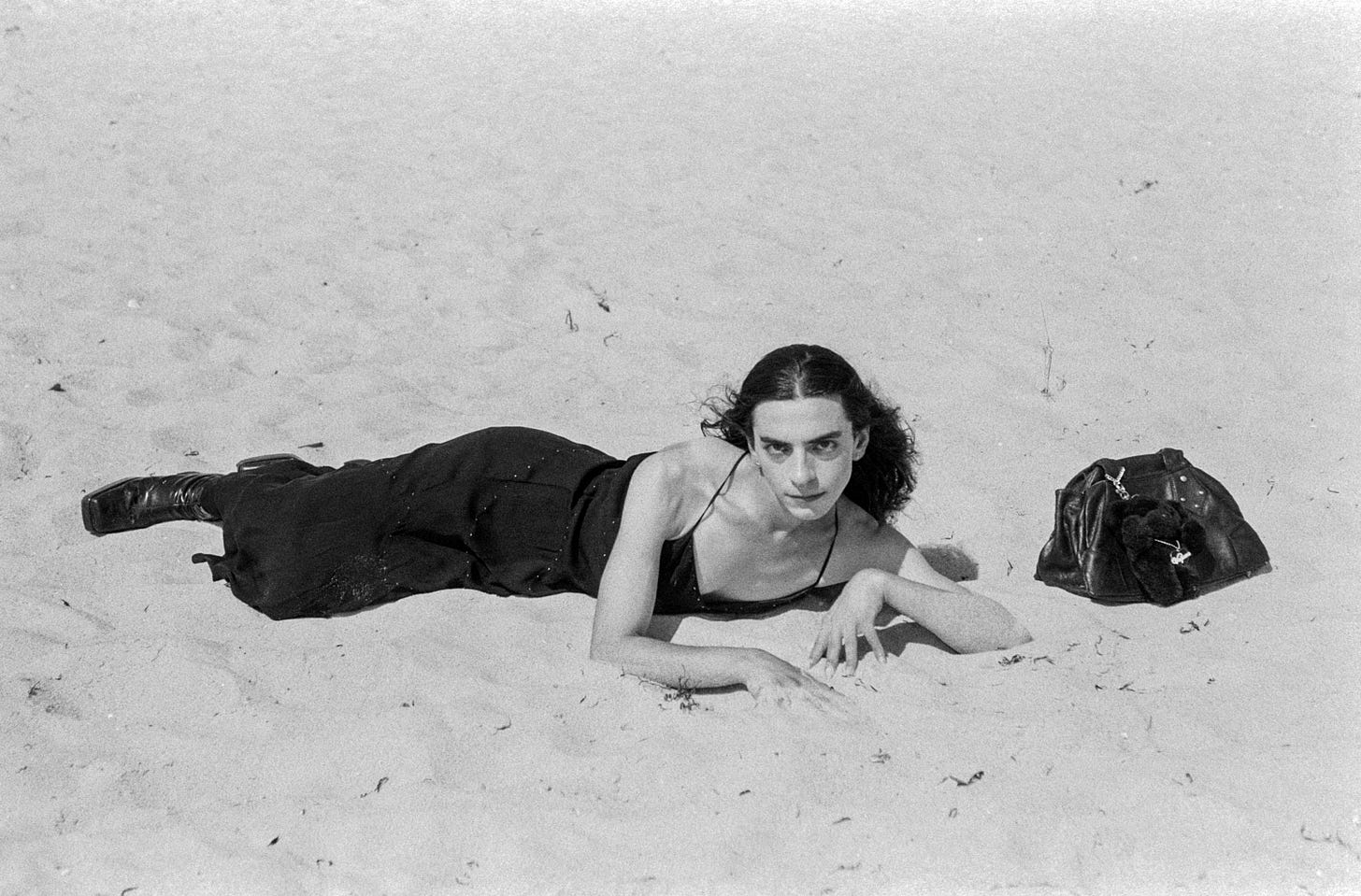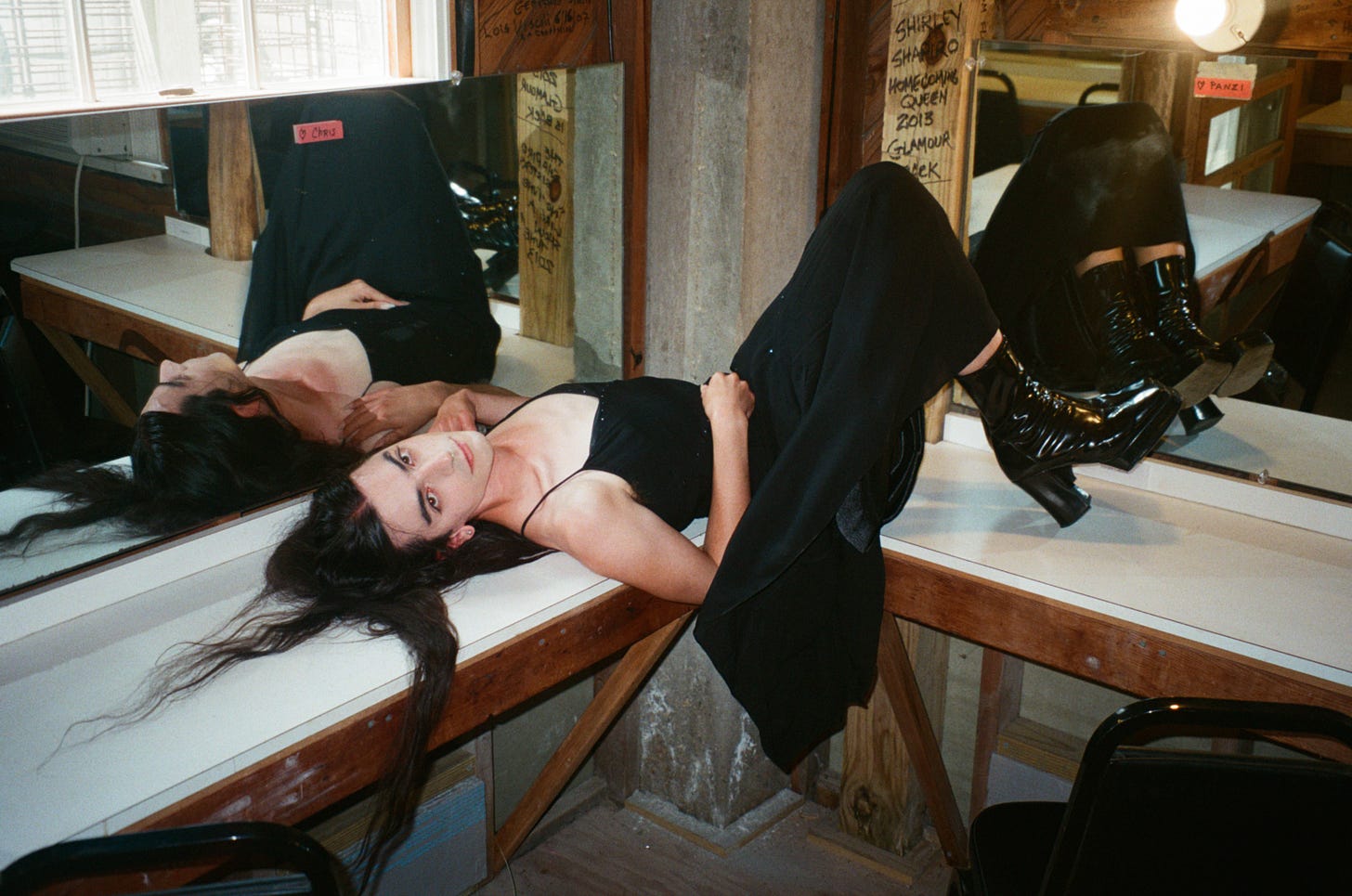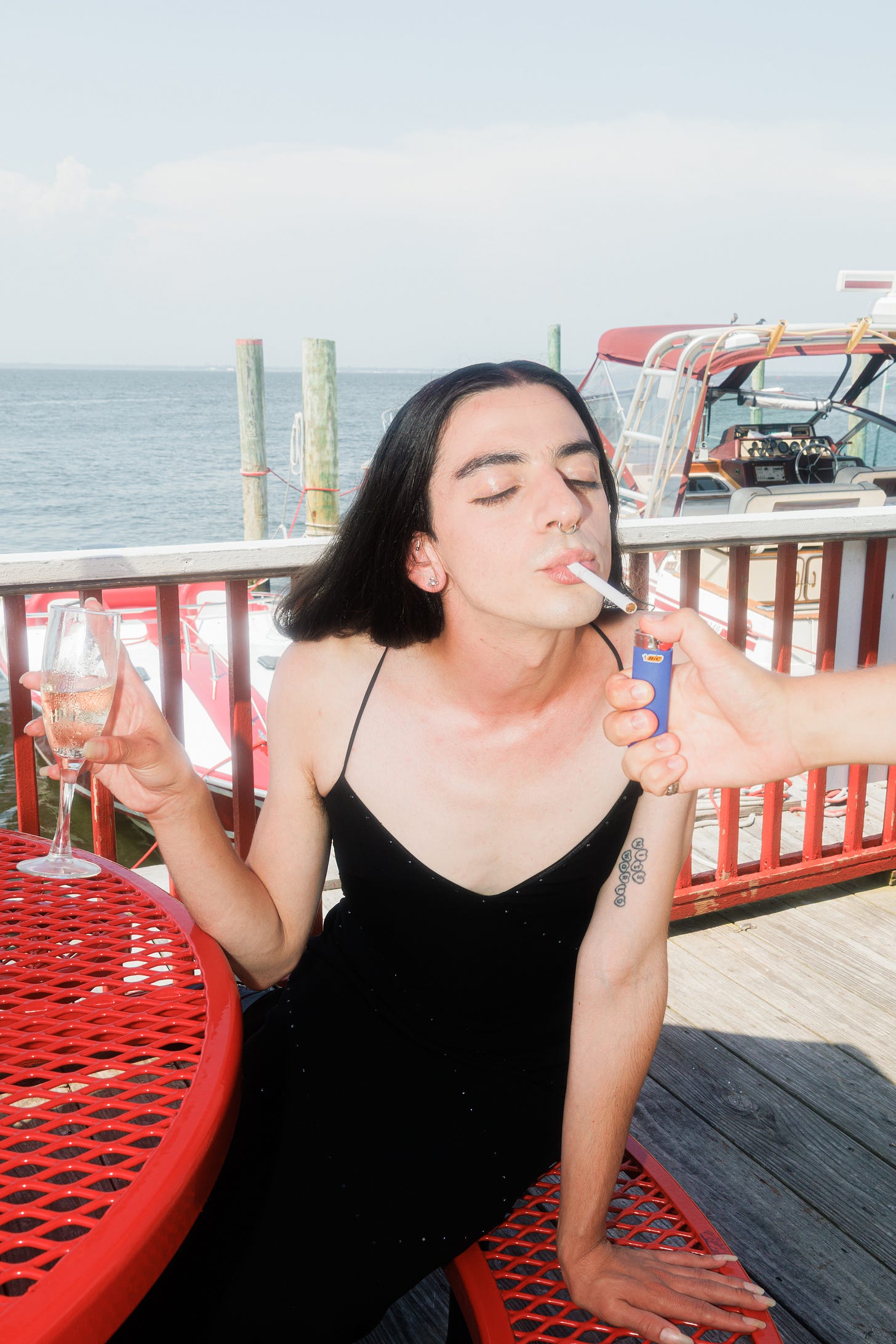Christopher Gambino’s Fire Island Study of Self and Stage
On queerness, objects, and the porous line between artist and performance.
New York–based artist Christopher Gambino moves between performance, sculpture, and narrative, building a world where bodies, objects, and gestures echo one another. During his time at the Fire Island Artist Residency (FIAR), he engaged the island’s long lineage of queer performance — from drag and cabaret to the playful and grotesque — as a space to test how queerness can live not just in subject matter, but in form. There, he continued his exploration of presence and absence, experimenting with narrative-driven sculpture and performance that blur the line between what’s staged and what’s felt.
What does queerness mean to you right now, in 2025? Has your understanding of it shifted in recent years?
I’ve tended to avoid identifying myself or my work as queer, as I don’t fully understand what it means. In trying to answer this question, I’m reminded of when I was a performance artist in college and kept being told that my work was about failure. I was kind of like, “Oh, okay, well, I didn’t know I was failing.” This led me to Jack Halberstam’s book The Queer Art of Failure, which essentially establishes the act of failing as a queer mode of doing. That is, failing at something is just finding a different way to accomplish it. I imagine this exact scene has played out with many other little queens in undergrad. It makes me think a lot about where queerness is actually located in something—is it in its content, or its form? I’m not sure. I think queer is maybe more of a feeling than anything else. In any case, it seems fundamental to me and my work, whether or not I put it there on purpose. There appears to be an otherness to me and everything I do that feels normal from the inside.
Last year, someone described my sculptures as crossdressers, and I was like, “What about this chair doesn’t seem cisgender to you?” They said, “Well, Christopher, chairs aren’t supposed to wear stockings.” So I wonder, is it more or less queer when I wear stockings or when a chair does? What about when a woman wears stockings? It didn’t really occur to me that the work was queer or that it involved the queering of anything, aside from the fact that it was created by someone who is queer and engaging with movements and subgenres that have historically been associated with boys—but even that is somewhat tenuous.
I think what I’m trying to say is that maybe queer is a feeling, a sense of wrongness or irreverence that only some of us are psychologically able to access, or a feeling that some of us can’t help but exude. It does feel wrong when I dress up, but that’s why I like it. Christopher occurs within that wrongness, in the distance between my body and the way I adorn it.
My feelings on queer as a descriptor for me and my work have changed, though, and I’m feeling a little less resistant to it. I don’t think I make work about queerness at all, but it does serve as a useful entry point for many people. If people who are queer see themselves in what I do, I think that means it has to be queer, and it would be obstinate for me to claim otherwise. I think there’s room to grow in the way we understand it as a term, though. I think we can make it a little sexier, a little more gross, a little less prescriptive. As it stands, it feels pretty ineffective at resisting categorization.
How did your work take shape during your time at the Fire Island Artist Residency? What projects or experiments did you focus on while you were there?
I spent most of my time at the residency developing and writing the score for a performance that is part narrative play, part cabaret act, and part Christmas special, which is the basis of my upcoming solo at Below Grand in New York.
In my sculptures, I’m trying to evoke the feeling of ephemera, as though some dance, gesture, or crime transpired, which resulted in the object or objects that the viewer sees. Whenever I see a pair of shoes abandoned on the street, I can’t help but construct some elaborate story about how and why these things landed where they did. Did the wearer have to kick them off to escape an assailant? Was she raptured? Did she find a nicer pair of shoes on the street and stop to change?
So, rather than reverse-engineering a narrative from the ephemera, as I usually do, with this work, I attempted to start with the narrative and allow it to inform the resulting objects. My background and education are in performance, and my sculptures are very much grappling with that—trying to negotiate the experience of seeing and being seen, of threatening and being threatened by the gaze. It was a disorienting experience to begin my object-based practice, in which I create objects that are translations of my own body, and then filter that back into my actual body again. Because Fire Island has historically fostered specific forms of queer performance, namely drag and cabaret, I knew it would be the perfect place to develop this work, as those are forms I’m explicitly engaging with and referencing. I also think being on island time was integral to the resulting script. Settling into the meandering, circular rhythm of Fire Island, with its days that feel at once extremely long and extremely short, informed my work and its structure profoundly.


Your Instagram bio says you’re a model and actress. Is this a cheeky way of pointing out professionalism standards in a hyperprofessionalized queer and creative life today? How do you play with the idea of performativity in your practice and larger aspects of your life?
Living and working as an artist often blurs the lines between the social and the professional. I feel a lot of pressure to be friends with everyone I work with and to use social media to advance my career and promote myself while also maintaining a strange veil of casualness, as though I’m running a personal account and not basically my LinkedIn. It’s disorienting, and I don’t know how to make it serve my needs without also playing a character. I’m aware of the expectations that exist of me based on the way I look, the way I dress, and the way I speak, and I’m interested in what it means to give the audience what they want.
It’s not lost on me that Christopher Gambino is an idea. I like to think that Christopher Gambino is a construct that I’m in control of, a sort of golem that I can pilot while protecting some of my interiority. There’s an element of mythmaking and storytelling to my practice and the work that I make, and I think the idea of artist-as-character is central to that. Because my work is also pretty formally naive, the visible presence of my hand is a part of its content. I do want viewers to imagine what kind of person made these objects. Maybe Christopher Gambino is some kind of perverted Gepetto, or a serial killer dispersing evidence, or a transvestite possessed by the ghost of a doomed prima donna. Or maybe Christopher Gambino is a twink with a shopping addiction who lives in Brooklyn. Who can say?
How do you choose the objects that appear in your work? Are they found intuitively, or do they come from long periods of collecting and research?
I’m a compulsive shopper and hoarder. I’m obsessed with collecting things. If I see something shiny on the ground, I’m going to pick it up. I have an insane number of objects in my studio. A visitor told me recently that they felt like they were in an evil church storeroom. I’ve come into possession of all the things that I keep in my studio because they spoke to me in some way, and when I feel moved by a thing, it’s usually because of its body-adjacency, like the curve in a table leg or the arch of a chair back.
I spend a lot of time with my objects, placing them in different positions and orientations, dressing them up, taking them apart. I feel like there are women hiding inside the things that I collect, and my process is one of finding her and coaxing her out, trimming away excess material so other people can see her too. I don’t usually source specific things; I prefer to let things find me, to let the thing tell me who she wants to be.
There’s also something about trash specifically that appeals to me. The act of discarding something gives it an entirely new layer of meaning. So much of the furniture and home goods that are abandoned on sidewalks, or clogging up thrift stores and estate sales, or gathering dust in your grandma’s attic, evoke a specific kind of Americana loaded with ideas of yearning and desire.
I think most of my materials are from the 80s, and a lot of the furniture from that time is these cheap approximations of other things—fake Chippendale chairs, imitation crystal, and other haunted, ahistorical mashups of European styles and eras. There’s an aspirational quality to this material, but it’s also tragic because it’s just a thing pretending to be another kind of thing.

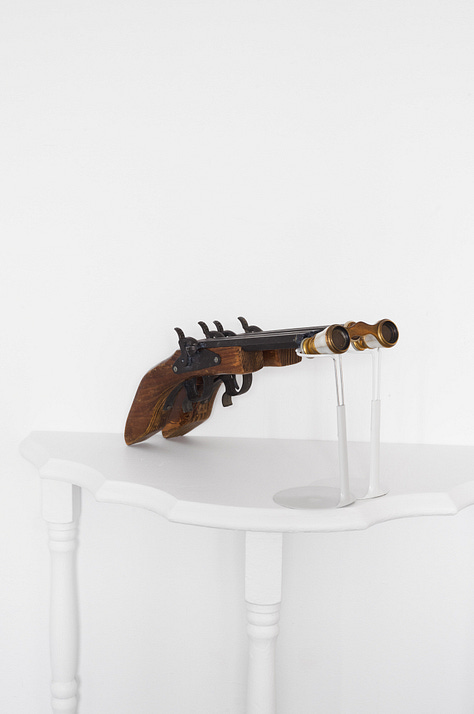
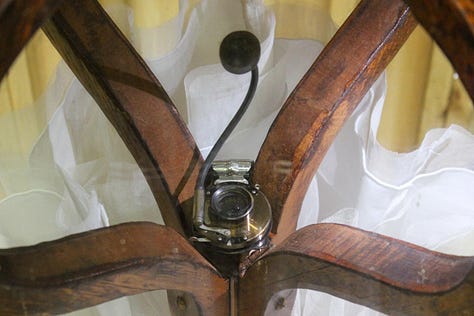
How did your own background and experiences before FIAR shape the way you encountered Fire Island and the community you found there? You are now part of its history.
To be completely honest, I was so afraid of Fire Island. I’ve spent a long time avoiding explicitly gay spaces, and I’m aware that my work is afforded a level of neutrality because I refuse to talk about my identity in most contexts. This has allowed my work to function in spaces and contexts that are not queer, and for the discussion around it to be largely formal.
Is there a particular memory, moment, or image from Summer 2025 on Fire Island that has stayed with you?
I saw the drag queen Rose Levine perform her show, The Unsinkable Rose Levine, at the Cherry Grove Community House, which was completely life-changing. Rose is the Guinness World Record holder for the oldest performing drag queen, at 94 years old, and has been performing in Cherry Grove since 1955. I can be a bit ironic and detached, so it was disarming for me to feel so deeply and sincerely moved by her performance. There was a moment when I realized I was the youngest person in the audience by decades (no shade) and that everyone in the room had been attending her shows for years, having grown old alongside her.
Of course, there’s an element of camp to my relationship with this kind of performance, but I was so emotionally caught off guard by the actual beauty of a performer forgetting the words to her song or trailing off mid-sentence. There was one moment in the show when two stagehands carried out a vanity table with a wig head and mirror, and they accidentally dropped the mirror, and it broke. They decided in the moment to use the broken prop mirror anyway, so they put it back on the table. Rose then removed her wig and sang “If You Could See Her” from Cabaret into the broken mirror. It was brilliant.
I had originally decided to attend the performance because of my fixation on showbiz aesthetics and the idea of artifice, but the beauty and sincerity of Rose’s performance has really given me a lot to process, and I will be reckoning with what it made me feel for a long time.




